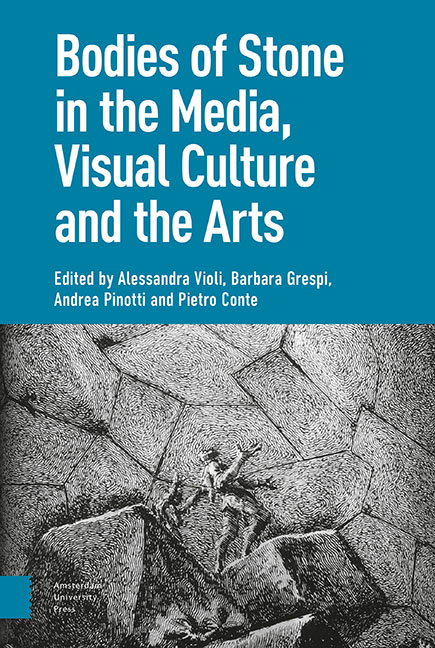Book contents
- Frontmatter
- Contents
- Introduction: Learning from Stone
- I Statue: The Imaginary of Uncertain Petrification
- 1 Theatre and Memory: The Body-as-Statue in Early Modern Culture
- 2 Translated Bodies: A ‘Cartographic’ Approach
- 3 Pantomime in Stone: Performance of the Pose and Animal Camouflage
- 4 Animated Statues and Petrified Bodies: A Journey Inside Fantasy Cinema
- 5 The Ephemeral Cathedral: Bodies of Stone and Configurations of Film
- II Matter: Size, Hardness, Duration
- 1 Bodies That Matter: Miniaturisation and the Origin(s) of ‘Art’
- 2 Brancusi’s ‘Sculpture for the Blind’
- 3 Cinema, Phenomenology and Hyperrealism
- 4 Ephemeral Bodies: The ‘Candles’ of Urs Fischer
- 5 The Celluloid and the Death Mask: Bazin’s and Eisenstein’s Image Anthropology
- III Corpse: Fossils, Auto-Icons, Revenants
- 1 Funeral Eulogy: Post-Mortem Figures and Redeemed Bodies, in Images
- 2 On Jack Torrance As a Fossil Form
- 3 Technical Images and the Transformation of Matter in Eighteenth-Century Tuscany
- 4 Glass, Mixed Media, Stone: The Bodily Stuffs of Suspended Animation
- 5 Bodies’ Strange Stories: Les Revenants and The Leftovers
- IV Monument: Embodying and Grafting
- 1 The Impassibly Fleshly, the Statue of the Impossible
- 2 Frozen into Allegory: Cleopatra’s Cultural Survival
- 3 The Orphan Image
- 4 The Well-Tempered Memorial: Abstraction, Anthropomorphism, Embodiment
- 5 Monuments of the Heart: Living Tombs and Organic Memories in Contemporary Culture
- Index
IV - Monument: Embodying and Grafting
Published online by Cambridge University Press: 20 November 2020
- Frontmatter
- Contents
- Introduction: Learning from Stone
- I Statue: The Imaginary of Uncertain Petrification
- 1 Theatre and Memory: The Body-as-Statue in Early Modern Culture
- 2 Translated Bodies: A ‘Cartographic’ Approach
- 3 Pantomime in Stone: Performance of the Pose and Animal Camouflage
- 4 Animated Statues and Petrified Bodies: A Journey Inside Fantasy Cinema
- 5 The Ephemeral Cathedral: Bodies of Stone and Configurations of Film
- II Matter: Size, Hardness, Duration
- 1 Bodies That Matter: Miniaturisation and the Origin(s) of ‘Art’
- 2 Brancusi’s ‘Sculpture for the Blind’
- 3 Cinema, Phenomenology and Hyperrealism
- 4 Ephemeral Bodies: The ‘Candles’ of Urs Fischer
- 5 The Celluloid and the Death Mask: Bazin’s and Eisenstein’s Image Anthropology
- III Corpse: Fossils, Auto-Icons, Revenants
- 1 Funeral Eulogy: Post-Mortem Figures and Redeemed Bodies, in Images
- 2 On Jack Torrance As a Fossil Form
- 3 Technical Images and the Transformation of Matter in Eighteenth-Century Tuscany
- 4 Glass, Mixed Media, Stone: The Bodily Stuffs of Suspended Animation
- 5 Bodies’ Strange Stories: Les Revenants and The Leftovers
- IV Monument: Embodying and Grafting
- 1 The Impassibly Fleshly, the Statue of the Impossible
- 2 Frozen into Allegory: Cleopatra’s Cultural Survival
- 3 The Orphan Image
- 4 The Well-Tempered Memorial: Abstraction, Anthropomorphism, Embodiment
- 5 Monuments of the Heart: Living Tombs and Organic Memories in Contemporary Culture
- Index
Summary
This final section considers the process of monumentalisation that stone produces ‘treating’ the body. The concept of the monument allows a reflection on mnemonic practices that structure our relationship to the heritage of images that is at the base of our collective imagery. The monument is an exemplary and paradigmatic case of mnestic externalisation: it is a visible image in which a community records its memory of an event, a person, a moment crucial to its history in order to avoid loss and forgetfulness.
If we look at the ways in which the monumental sensibility of an epoch expresses itself, we will at the same time have a vision of the balance that each epoch negotiates between the dimensions of memory and oblivion. As Plato clearly stated in his dialogue Phaedrus(274e-275a), and as Jacques Derrida more recently repeated in his Plato's Pharmacy(1968), any device assuring an externalisation of our recollections produces an intrinsically paradoxical effect: trusting the medium to remember on my behalf, I can allow myself to forget. Similar to the paradoxical effect known in pharmacology (for instance, pain caused by a pain relief medication), the aids for remembering end up causing amnesia: they represent a veritable pharmakon, at the same time medicine and poison for memory.
In the longue dureethat runs from ancient Greek philosophy to contemporary psychological and neurological memory modelisations, what is particularly intriguing is the fact that the externalisation paradigm, far from applying only to actually externaldevices (from writing tablets to digital clouds), informs the way in which internalprocedures of memorisation are understood. The possibility of memory is conceived of as structurally linked to the possibility of the graphic inscription. From Plato's metaphor of the soul as a wax block, described in his dialogue Theaetetus(191c), through Aristotle's On the Soul(430a) and On Memory and Reminiscence(450a) to Freud's A Note upon the “Mystic Writing Pad”(1925) and down to the contemporary cognitive neuroscience of memory, the influential model of recollection as a kind of script reading has rested on the notion of imprinting as the condition of possibility for the production of the mnemonic trace. The conceptualisation of the internal memory is consequently inspired by the procedures of the externalised memory; internal remembering operates like the reminding and retrieving of an imprinted external trace.
- Type
- Chapter
- Information
- Bodies of Stone in the Media, Visual Culture and the Arts , pp. 289 - 294Publisher: Amsterdam University PressPrint publication year: 2020

